

Celebrate the Lab’s 75th Birthday at Founders Day
Safety Management Improves, but More Work is Ahead
Celebrate the Lab’s 75th Birthday at Founders Day
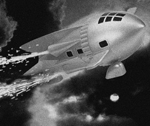
Flash Gordon episodes, along with other classic 1930s movies, will be screened at the building 50 “Cinema” on Founders Day
Performances by a fire spinner, an antique car show, a time capsule dedication, and the screening of classic 1930s movies are just some of the numerous fun-filled activities awaiting employees, retirees and their families and guests who attend Founders Day next Saturday (Aug. 26), from 10 a.m. to 3 p.m.
The celebration marks the day 75 years ago that founder Ernest Lawrence received authorization to open a Lab where he could advance his studies of particle acceleration.
There will also be a kid’s area, complete with bounce house and hands-on science experiments, tours of the Lab and various facilities, an arts and crafts show, an exhibit sponsored by the Environmental Energy Technologies Division, information tables, and a presentation of “When Things Get Small,” a video on the fascinating world of nanoscience.
To take advantage of these and other Founders Day events, employees should be aware of a few important details.
- Guests and retirees without a Lab ID badge or parking permit will need a special pass to enter the Lab.
- All parking lots, except the cafeteria, H1, H2, and Bldg. 50, will be open. Some handicap parking will be available in the cafeteria lot.
- The Blackberry and Strawberry gates will be open.
- Shuttle buses will pick-up and drop-off visitors in downtown Berkeley and circle the Lab throughout the event.
- Staff are welcome to show family members and friends their work site, but care should be taken when visiting buildings to ensure the safety of all guests.
Visit the Founders Day website for complete information on activities, RSVP, guest passes, food, parking, and transportation. The site is accessible from the Lab’s homepage: click the 75th Anniversary logo, then the Founders Day link on the left side of the anniversary page.
Check the website and Today at Berkeley Lab for updates. Programs will be available on the day of the event at the Information Tent in the cafeteria parking lot.
Safety Management Improves, but More Work is Ahead
Workplace safety, a top priority at Berkeley Lab, is improving thanks to a concerted effort by a wide range of Lab employees that has spanned several months. The most recent milestone comes from a team of Department of Energy safety experts who visited Berkeley Lab in June and determined that the Lab is well on its way to improving its safety practices. The team added, however, that more work needs to be done.
“The DOE team found a strong commitment at Berkeley Lab to improve its safety performance,” said Howard Hatayama, acting division director of Berkeley Lab’s Environment, Health, and Safety (EH&S) Division. “But there are ways to improve, and we will do so by shoring up the foundation that Berkeley Lab has established over the years.”
The process began last year when Berkeley Lab experienced several safety-related problems, such as poor laser safety practices and several electrical safety incidents. The Lab also missed its injury reduction goals for 2005, which are used by DOE to evaluate the Lab’s safety performance.
In response to these problems, an external team of nine safety experts conducted a peer review of the Lab’s integrated safety management system over a three-day period in January. The review was commissioned by the University of California with representatives from other national labs and academic institutions. Overall, the team was impressed with the current safety attitude of those interviewed and the proactive nature of the Lab’s leadership and staff in addressing safety issues.
But the peer review also found several shortcomings. Many employees, regardless of their level of authority, were reluctant to report incidents. Mid-level managers were the most vulnerable link in the safety management chain. Processes for identifying and controlling safety hazards needed to be applied more consistently across the Lab. There was also an overall need to ensure more consistent safety implementation and communication throughout the management chain and across divisions. This last point — communications — was determined to be the most crucial weakness by the peer review team. They found that supervisors and principal investigators needed to be more effective in communicating to their staff that safety goes hand-in-hand with research.
“The issue isn’t that supervisors and principal investigators don’t want to be safe. Instead, the challenge is that much of their staff is often composed of post-docs, visitors and students who are here for a short period of time, so it’s difficult to instill and sustain a strong safety culture,” said Hatayama.
After the peer review, Hatayama and his staff convened a group of people from throughout the Lab to develop a corrective action plan that addressed the peer review’s concerns. This plan is organized according to five broad categories. Among them is educating managers, supervisors, and coordinators on their role in ensuring a safe workplace for their staff. The action plan also outlines ways to improve how employees are authorized to work with potentially hazardous materials and tools such as lasers. In addition, the corrective action plan seeks to make safety as integral a part of Berkeley Lab’s culture as cutting edge research.
“We are trying to build on the positive safety attitude and generally sound approach to safety management that the peer review found,” said Hatayama.
In late June, the DOE team visited Berkeley Lab to determine how well the Lab’s corrective action plan answered the peer review’s concerns. The team found that the corrective action plan addressed the issues raised by the peer review. They also recommended that Berkeley Lab consider performing a more robust independent assessment of its safety practices. The team felt that the peer review was not sufficiently comprehensive, and the Lab would not fare well if the DOE Office of Independent Oversight were to conduct a safety audit today.
In response to this feedback, the Lab has commissioned a review patterned after how a DOE audit would be conducted. This review will be led by the consulting firm McCallum-Turner, with participants from other Office of Science laboratories. They will be here September 19 - 27, conducting interviews, reviewing documents and observing work. In preparation for this review, it is critical that all Lab employees understand the Lab’s Integrated Safety Management System, how it works, and what each employee’s role and responsibilities are in planning and authorizing work. Employ-ees can find out more about the review, and refresh themselves about ISM, by visiting http://www.lbl.gov/ ehs/ism/external-audit/.
“By agreement with DOE, this is a ‘no-harm, no-foul’ review. It’s critical that we view this as an opportunity to improve our safety performance by being as candid as possible with the reviewers,” said Hatayama. “Our goal is a safer Lab through the active and effective participation of everyone, from senior leadership to mentors to individual employees.”
Falcone Named New ALS Director
Roger Falcone, an ALS staff scientist and veteran user of the facility, as well as a UC Berkeley physics professor, has been appointed director of the Advanced Light Source, effective Sept. 1.

Roger Falcone
“Roger Falcone has been a leader in the fields of ultrafast science and x-ray studies of advanced materials,” said Berkeley Lab director Steven Chu in announcing the appointment. “He has a broad understanding of the fields of interest to the ALS user community and is extremely well poised to lead the ALS into the future of soft x-ray science and technology. As former chair of the Physics Department at UC Berkeley, Roger has proven leadership experience. We look forward to a wonderful and exciting new era at the ALS under his direction.”
Falcone succeeds Janos Kirz, who has been directing the ALS in an interim capacity since June of 2004, when he took up the reins of leadership on behalf of Daniel Chemla, who was sidelined by illness.
“I am thrilled with this announcement,” said Kirz. “Roger is superbly qualified for the job of ALS Director and a terrific choice to lead the ALS to even greater achievements.”
Falcone is a veteran user of the ALS. Among other achievements, he was the co-author, along with Robert Schoenlein, of a proposal that brought in beamlines 6.0.1 and 6.0.2, dubbed the Ultrafast X-Ray Facility, which are optimized for the generation of femtosecond x-ray pulses. A femtosecond represents one millionth of a billionth of a second, and is the timescale upon which chemical bonds are formed or broken, or materials transition from one phase to another. The Ultrafast X-Ray Facility is the first such facility at a synchrotron radiation source.
“I have been involved with the ALS as a user for ten years and with the Berkeley campus and lab community for over 20 years,” Falcone said. “I greatly enjoy working with the people here, from the staff to visiting scientists. We have an exceptionally committed and talented group at the ALS, and a world-class facility that our supporters in Washington recognize as a national treasure.”
Falcone has also been an active member of the synchrotron light source community. He became a faculty staff scientist at the ALS in 2004. He also serves as a consultant for the Lawrence Livermore National Laboratory and chairs the science advisory committee for the Linac Coherent Light Source (LCLS), now being built at Stanford. When completed in 2009, the LCLS will be the world’s first x-ray free electron laser.
“I look forward to working to maintain our excellent current programs, and growing new programs in response to the needs of the scientific community,” Falcone said. “Directors Janos Kirz and Daniel Chemla have done an exceptional job of getting us to where we are now, and I plan to carry on in their tradition.”
Falcone is a Fellow of the Amer-ican Physical Society, the Optical Society of America, and American Association for the Advancement of Science. He has also been a strong advocate for science education, having served on the Lafayette school board, and worked extensively with the Lawrence Hall of Science’s K-12 programs.
Levitating the Plinth—How the Nanowriter Made Its Way Home
When Jeff Bokor was looking for the world’s best electron-beam nanolithography machine for the Molecular Foundry’s Nanofabri-cation facility, which he directs, he had in mind an instrument like the Leica Nanowriter already installed in Bldg 2, part of the Center for X-Ray Optics. But Bokor found that the Nanowriter had already evolved. The Foundry acquired its $4-million successor instead, made by Vistec Lithography, Ltd. in Cambridge, England.
Just one catch. “It’s bigger, it’s better, but it won’t fit in the elevator,” Bokor explained, because the new Nanowriter’s cast-concrete plinth — the solid base on which the accelerator column stands, like a statue on its base, weighs almost four and a half metric tons, a ton and a half heavier than the old model’s.
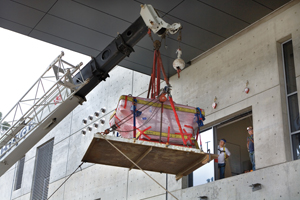
The Nanowriter, attached to its concrete plinth, is lowered by crane into its second floor destination
Since the Nanowriter’s new home is a clean room on the second floor of the Molecular Foundry, some way had to be found to bring it in from the outside of the building. The first part seemed easy — demolishing a wall and knocking out a wide window in the kitchen at the end of the second-floor hall, which overlooks the service drive. But the building’s dramatic third-floor thrust out over the drive meant a tight squeeze for the crane that had to lift the massive plinth without tipping it over.
Once through the hole in the wall there was a long way still to travel, over a floor not rated to bear the weight in the plinth’s small footprint. The trick was to inflate six “air bearings” or “skids,” keep them inflated to a constant pressure by long hoses from a compressor, and literally walk the ponderous object to its destination, a load-bearing pillar in the clean room, on a cushion of air.
The carefully planned operation began at 6:30 a.m. on Friday morning, July 28, and ended well over 12 hours later. Among the people on hand were managers and workers from Vistec, from Import Export Services, Ltd., who packed and loaded the plinth in England, from the carriers who brought the machine to the Bay Area by air and truck, and from 2XL, Inc., a local electronic rigging and transportation firm, in addition to Berkeley Lab’s Facilities personnel.
At the end of a very long day, Jim Bustillo of Materials Sciences, who oversaw the move, said, “It all went A-OK — mission accomplished, and not a scratch.”
To the Nanowriter, that is. Putting the building back together again around it was a mission for another day.
College Student Can’t Get Enough of Berkeley Lab
Asked what he wants to do with his life, college senior Arran Blattel said with a grin, “I want to save the world.”
At four he opened a savings account to help the homeless. While in elementary school he joined a hiking club to promote nature conservation. In high school, he applied to the Lab’s education outreach program for the first time to get a taste of research. This summer he returned to Berkeley Lab to figure out just how he’s going to achieve his goal.
Blattel is one of an increasing number of college students returning to Berkeley Lab after attending during their high school years. His presence exemplifies the success of the Lab’s outreach program, said Rollie Otto, department head of the Center for Science and Engineering Education which places students like Blattel at Berkeley Lab.
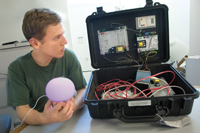 Arran Blattel
Arran Blattel
“The High School Student Research Participation Program was created in part to encourage talented local students to pursue careers in science, engineering and computer sciences with the hope that Berkeley Lab would be an employer of first choice,” Otto said. “Berkeley Lab is part of a diverse ethnic and cultural community and we are starting to see that this pipeline approach is working with increasing numbers of former high school students returning to the Lab as college interns or student assistants each year.”
Majoring in interdisciplinary earth sciences at Stanford University, with minors in economics and computer programming, Blattel is well matched for the job with his mentor, Mary Ann Piette of the Environmental Energy Technologies Division. The research group is developing a program that would interact directly with participating businesses to reduce their energy use when demands approach the power grid’s maximum capacity.
Working with staff member Sila Kiliccote, Blattel is programming an interface to automatically control building environmental systems, a task he finds challenging but rewarding, he said. The job has taught him to be persistent, overcoming blocks when he doesn’t know what to do, and identifying the right resource when he needs help, he said.
“There’s the satisfaction of getting a breakthrough and thinking, ‘Yeah, this works,’” Blattel said, nodding. “It’s a good feeling.”
In addition, he supports the research team by taking surveys of participating businesses’ experiences during energy conservation mode. He also helps test a Web site designed to allow energy customers to see their own usage profiles without gaining access to others’ information.
While he may not have figured out how to solve the world’s problems just yet, Blattel said he enjoys his work here at the Lab in energy conservation because it’s “close to home, applicable right here, right now. It’s the people side of environmental systems.”
By the end of his 10 weeks he will have to design a poster, including an abstract, about the project. In addition, he’s taken it upon himself to write a paper which, if it passes a review, will be published in the Department of Energy’s Journal of Undergraduate Research.
Blattel said he takes full advantage of the resources available at the Lab, attending events when possible to learn about different careers and research. He makes it a point to talk to people and find out more about them, what research they are doing, how they got there. “I want to make the most of it while I’m here,” he said.
Berkeley Lab View
Published once a month by the Communications Department for the employees and retirees of Berkeley Lab.
Reid Edwards, Public Affairs Department head
Ron Kolb, Communications Department head
EDITOR
Pamela Patterson, 486-4045, pjpatterson@lbl.gov
Associate editor
Lyn Hunter, 486-4698
STAFF WRITERS
Dan Krotz, 486-4019
Paul Preuss, 486-6249
Lynn Yarris, 486-5375
CONTRIBUTING WRITERS
Jon Bashor, 486-5849
Allan Chen, 486-4210
David Gilbert, (925) 296-5643
DESIGN
Caitlin Youngquist, 486-4020
Creative Services Office
PHOTOGRAPHY
Roy Kaltschmidt, 486-5731
Creative Services Office
Berkeley Lab
Communications Department
MS 65, One Cyclotron Road, Berkeley CA 94720
(510) 486-5771
Fax: (510) 486-6641
Berkeley Lab is managed by the University of California for the U.S. Department of Energy.
Online Version
The full text and photographs of each edition of The View, as well as the Currents archive going back to 1994, are published online on the Berkeley Lab website under “Publications” in the A-Z Index. The site allows users to do searches of past articles.
Flea Market is now online at www.lbl.gov/fleamarket
Lab Coordinates Avian Flu Pandemic Forum
On August 1, Berkeley Lab joined several other Alameda County and state agencies at a one-day forum designed to prepare healthcare and emergency leaders for the day when the avian flu reaches the Bay Area.

The forum, which was coordinated by Berkeley Lab, was Alameda County’s first pandemic flu preparedness meeting. It brought together more than 130 people from law enforcement, emergency services, community groups, schools, local hospitals and city governments.
“In order to prepare for a pandemic, Berkeley Lab has built bridges to Alameda County health officials as well as state health and emergency services,” says Berkeley Lab’s Security Manager Dan Lunsford, who helped organize the forum. “We are working to be prepared if the bird flu arrives.”

It’s just a matter of time, experts say. According to a recent World Health Organization report, 133 people have died worldwide from the Influenza A (H5N1) virus since 2003. This “bird flu” virus is highly contagious among birds and does not often infect people.
However, because influenza viruses have the ability to change, scientists are concerned that the H5N1 virus could eventually infect and spread easily among humans, who have little or no immune protection against it, causing a worldwide influenza pandemic.

Currently, the closest infected birds are in Siberia, which is only three miles from Alaska and on the doorstep of a migratory pathway that extends far south of California.
“We could see infected birds in our area before the end of the year,” said Berkeley Lab’s Health Services Manager Dr. Peter Lichty.
The presence of infected birds in the Bay Area doesn’t mean a pandemic will occur. But if the virus mutates and easily jumps from person to person, then even people in the prime of their lives could become very ill.
The forum was held at Alameda County’s Office of Homeland Security and Emergency Services. In coordinating the event, Berkeley Lab partnered with the Alameda County Medical Center, Alameda County Public Health Department, Alameda County Sheriff’s Office of Homeland Security and Emergency Services, UC Berkeley’s School of Public Health, and CARD — Colla-borating Agencies Responding to Disasters.

The meeting was intended to jumpstart a planning process that will result in a locally led response to an avian flu pandemic, if it occurs. It was also intended to increase collaborations between these groups in the event of a wide range of public health crises and emergencies. The need to band together at the local level is underscored by the federal government’s recent announcements that it can only offer limited help in the event of a pandemic.
“We are largely on our own,” said Dr. Anthony Iton, Alameda County’s health officer. Despite the potential for widespread disruptions sparked by a pandemic, Iton added that there is little chance he will mandate the closure of businesses and other facilities to contain the spread of the virus.

“I can’t envision any scenario in which we would shut down Berkeley Lab or other local facilities,” said Iton. “Our goal is to keep businesses running as smoothly as possible. As long as people follow basic health precautions, we should be able to do that.”
Currently, several Environment, Health, and Security (EH&S) Division personnel are developing a plan that outlines Berkeley Lab’s response to the potential pandemic.
Summer Lecture Series — Particle Accelerators and Element
The last of the summer lectures focused on particle accelerators and their products, a fitting end to the 75th anniversary series, for it was Ernest Lawrence’s invention of the world’s first cyclotron that brought Berkeley Lab into existence.
75 Years of Particle Accelerators
Award-winning theoretical physicist and former Berkeley Lab director Andy Sessler conducted a whirlwind tour of the history of particle accelerators. Lawrence’s milestone invention of the cyclotron should be taken in context with the work of those who paved the way, Sessler said.
Ernest Rutherford first conceived of using accelerated nucleons to produce nuclear reactions at the turn of the century. The first particle accelerators were electrostatic devices such as John Cockcroft’s and Ernest Walton’s machine which, in 1932, became the first to generate a nuclear reaction though a voltage multiplying column, using technology similar to Van de Graaff’s generator of 1929.
In 1940, largely because of the contributions of William Hansen, linear accelerators, or linacs, were invented. At two miles, the Stanford Linear Accelerator is currently the world’s longest. Most linacs are used to research high-energy physics and to inject fast-moving particles into other accelerators.
The invention of the Betatron in the 1940s allowed physicists to accelerate electrons to higher energies than previously possible. Today suitcase sized betatrons detect defects in steel beams, ship’s hulls, and other large, forged items. By tinkering with a betatron, Frank Goward of the United Kingdom conceptualized the first synchrotron in 1950.
The 1950s also witnessed the development of the collider, invented by several scientists working independently. These devices now create the highest energy particles. CERN’s Large Hadron Collider, at 28 km in circumference, will be the world’s largest particle accelerator when completed.
Cyclotrons, meanwhile, have evolved from Lawrence’s modest 27-inch invention to the 59-foot behemoth TRIUMF, of Canada.
Discovery of the Transuranium Elements
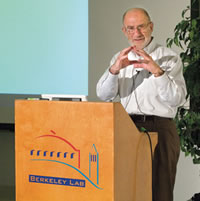 Andy Sessler
Andy Sessler
Particle accelerators such as the 60-inch cyclotron at Berkeley Lab unleashed the ability to create trans-uranium elements, said Darleane Hoffman, a pioneering woman in nuclear chemistry. Now a UC Berkeley graduate school professor, Hoffman recounted the quest for heavy elements. Since its discovery in 1789, uranium remained the heaviest known element for over 150 years. Enrico Fermi’s attempts to produce transuraniums in 1934 failed. Germany’s Ida Noddack challenged his results, proposing they were the products of nuclear fission, not the reaction Fermi had proposed. She was ridiculed for her hypothesis until it was confirmed by Austrian chemists Lise Meitner and Otto Hahn.
Then, in 1940, Phillip Abelson visited Berkeley Lab and in just five days, collaborating with Nobel Laureate Edwin McMillan, discovered neptunium before returning home. A year later, McMillan, Nobel Laureate Glenn Seaborg, Arthur Wahl, and Joseph Kennedy discovered plutonium. Seaborg’s later research yielded americium, curium, berkelium, californium, einsteinium, fermium, mendelevium, nobelium, and seaborgium.
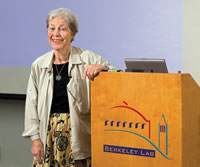 Darleane Hoffman
Darleane Hoffman
Transuranium elements eluded researchers for so long in part because of the inaccurate periodic table, created by Mendeleyev in 1869 and largely untouched since, which scientists used to predict elemental properties. Seaborg noticed discrepancies in the predictions while pursuing his search for transuranium elements and in 1945 redesigned the table to include the actinide series.
Progress in synthesizing trans-uranium elements trails innovations in technology, Hoffman said. Currently, scientists are limited by their ability to accumulate neutrons at a target. Identification of elements can be problematic, she said. Elements 112 through 116, discovered in the last 10 years, will have to be confirmed before they can be officially named.
From Duct Tape to Dark Energy: Shank’s Directorship Continues: Unexpected Discoveries in Times of Tumult
 Science announces Accelerating Universe is Breakthrough of the Year
Science announces Accelerating Universe is Breakthrough of the Year
By the mid-1990s the United States was a nation of ironic extremes. Wealth and waste coexisted with homelessness and illiteracy. Terror and violence threatened at home and abroad, from Columbine to the World Trade Center to the Middle East. The burgeoning internet brought spam and scam along with knowledge and communication; the dot-com economy was as flimsy as it was grandiose. We were addicted to oil, we were desperate for energy efficiency, and we were changing the climate — we knew all that, or at least we had good evidence for it, but meanwhile we flew to the ends of the Earth on adventure travels and bought gas-guzzling SUVs as readily as we bought cell phones.
Charles Shank kept a firm hand on Berkeley Lab’s tiller through these increasingly tumultuous times; a network of connections with far-flung, cutting-edge science programs and Shank’s familiarity with the ins and outs of Washington played a major role in keeping the Lab on a steady course.
The Lab’s research heading into the new century was just as eclectic and surprising as the era. The year 1998, to pick one example, brought wide media attention from two wildly different discoveries. One, that the expansion of the universe is not slowing as expected but accelerating, was named Science magazine’s “Breakthrough of the Year.” The other, that duct tape is good for anything except sealing ducts, won rather different kudos, including a raucous review by Tom and Ray Magliozzi on NPR’s “Car Talk.”
In Service to Society
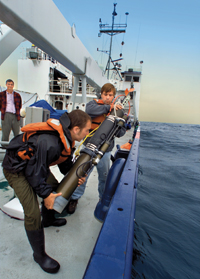 Researchers launching Carbon Explorer floats in the Pacific Ocean
Researchers launching Carbon Explorer floats in the Pacific Ocean
These seemingly asymmetric discoveries were indications, among many others, of the major trends in science and society directly fueled by Berkeley Lab research. Take duct tape: replacing it with a sealant that works, like the Aeroseal system developed in the Environmental Energy Technologies Division, saves home and building heating energy and dollars. A raft of other advances in energy efficiency included cool roofs, windows that can alter reflectivity, and economical (and safe) lighting systems like the cool fluorescent torchiere and the Berkeley Lamp.
EETD director Mark Levine was early to recognize the energy implications of China’s rapidly growing economy; he forged ties with the government of China, at first concentrating on Chinese refrigerators, the largest refrigerator economy in the world. Berkeley Lab’s China Energy Group signed agreements in 1999 that have grown into a vital role in advising China’s energy policy.
Sally Benson, Earth Sciences Division director in the mid-90s, led a broad effort to understand the carbon cycle and to find ways of sequestering excess carbon pumped into the atmosphere. By early 2004 the first tests of geological carbon sequestration were scheduled for deep brine aquifers in Texas, aided by an increasingly sophisticated family of simulation codes, called TOUGH, for simulating fluid and heat flow in porous and fractured underground media like depleted oil and gas reservoirs.
Terrestrial carbon studies pointed to the danger from fires, hurricanes, and flooding as the global temperature increased. Jim Bishop’s Carbon Explorer floats monitored and reported on particulate carbon in the upper ocean, leading to breakthroughs in understanding how plankton absorbs carbon from the atmosphere even in the inhospitable reaches of the Northern Pacific and the Southern Ocean.
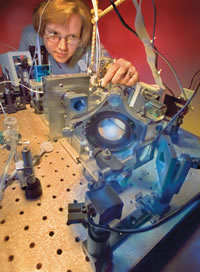 Carlos Bustamante's Optical Tweezers
Carlos Bustamante's Optical Tweezers
Mina Bissell and Joe Gray, her successor as director of the Life Sciences Division, used new biological knowledge to deepen understanding of what was becoming known as “systems biology.” The Joint Genome Institute, a consortium of DOE national laboratories Lawrence Berkeley, Lawrence Livermore, and Los Alamos, opened for business in December, 1997, and an accelerating flow of genome data stimulated emphasis on systems biology and its close relative, quantitative biology. Early in 2001, working drafts of the human genome were published in Science and Nature; the JGI contributed sequences of human chromosomes 5, 16, and 19.
With the aid of faster computers and more advanced algorithms, studies of gene regulation intensified. Rapid sequencing renewed interest in proteins, including how they are structured and how they work, whether alone or together as “machines” to perform the business of the cell and organism. X-ray crystallography at the Advanced Light Source plus a range of microscopic techniques revealed structures for the ribosome and other important protein machines and individual proteins at the highest resolutions ever.
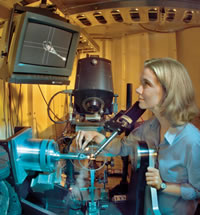 Protein Crystallography at the Advanced Light Source
Protein Crystallography at the Advanced Light Source
Scientific computation played an ever more important role in research under the direction of Bill McCurdy and Horst Simon. NERSC helped rewrite the equations of turbulence (disproving the “Law of the Wall”), find the first solution to the three-charged-particle problem in quantum chemistry, investigate the intricate electronic pathways of photosynthesis, model and visualize gas flames and particle accelerators and the world’s climate — from local neighborhoods to continents, oceans, and the whole globe — and even model the interior of the earth, the shapes of exploding stars, and how black holes collide.
Almost as remarkable as these supercomputer feats was an algorithm cooked up by David Bailey and his colleagues that could find any binary digit of pi in a few seconds with a desktop PC; it was named one of the top 10 “algorithms of the century.”
NERSC was a contender in the computing power sweepstakes throughout the 1990s. The IBM machine named “Seaborg,” in honor of the Lab’s great chemist who had died in February, 1999, was the most powerful unclassified supercomputer in the world at the beginning of the new century. But a year later Japan’s custom-made giant Earth Simulator jumped ahead of general-purpose machines — forcing U.S. computing scientists, with a Berkeley Lab team involved in leading the effort, to rethink the nature of scientific computing.
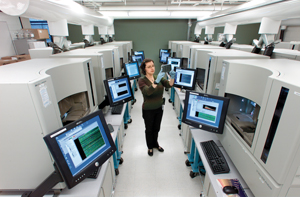 Sequencers at the Joint Genome Institute
Sequencers at the Joint Genome Institute
During the Shank years the Lab also led in computing connectivity. Lab-led teams achieved victory after victory in High-Performance Band-width Challenges at supercomputing conferences, moving ever-larger amounts of data in record time. The Lab was the home of ESnet, managing the high-speed data communications network that connected scientists and collaborators worldwide with DOE research and computing facilities. The Lab’s Van Jacobson was co-creator of Multicast Backbone, or MBone, the technology that made live internet videocasting practical; mileposts included hosting a Rolling Stones concert in 1994 and hooking up to the Antarctic research station in 1998.
In the Antarctic winter of 1999, subsequent computer connections by Berkeley Lab personnel helped establish live medical consultation with a woman doctor who had discovered a lump in her breast, at a time when the research station was so isolated planes could not land or take off in the subfreezing darkness.
From Science Fiction to Science
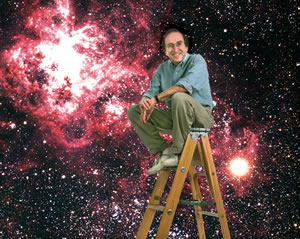 Saul Perlmutter, Supernova Cosmology Project
Saul Perlmutter, Supernova Cosmology Project
Two fields of study gained special prominence during the latter half of Charles Shank’s directorship. In the early 1990s one of them, nanoscience, was more science fiction than science. The other, dark energy, couldn’t be found even in fiction.
But by the late 1990s nanoscience was real, aided at Berkeley Lab by tools like an electron-beam nanowriter, atomic-force microscopes, scanning tunneling microscopes, photo-emission electron microscopes at the ALS and record-breaking microscopes at the National Center for Electron Microscopy, able to pick out atoms as small as lithium next to heavy atoms in compound crystal lattices.
Soon to come were the nanorods, nanotetrapods and nanoarrowheads of Paul Alivisatos, who would later combine nanostructures and polymers into semiconducting hybrid solar cells. Alex Zettl led the development of telescoping nanotubes, nanotubes loaded with buckyball BBs, a new kind of buckyball, C-36, and the world's tiniest motors. Discoveries like these on the materials sciences side, "from the atom up," rapidly merged with new biological techniques, "from the microbe down."
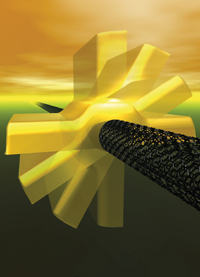 The synthetic rotational nanomotor, measuring between 100 and 300 nano-meters in length
The synthetic rotational nanomotor, measuring between 100 and 300 nano-meters in length
Novel techniques for studying and manipulating cells ranged from optical tweezers to nanocrystal tracers to cell engineering. From Carolyn Bertozzi’s research on living cells that grew artificial components on their surfaces, it was a short step to synthetic biology. Graham Fleming, then director of the Physical Biosciences Division, founded the nation’s first Synthetic Biology Department in 2003.
Meanwhile Shank championed the Molecular Foundry, proposed in 2001 by Daniel Chemla, then director of both the Materials Sciences and ALS divisions, who intended “to change the paradigm for nanoscale materials research.” Dedicated in March 2006, the Foundry is the first of five proposed DOE nano-science research centers and the only one on the West Coast.
Research, to borrow Jorge Luis Borges’s memorable phrase, is a garden of forking paths. Neutrino oscillation, made possible by neutrino mass, was confirmed by SNO in 2001, an “expected surprise.” But no fork in the physics path was more unexpected than the discovery of dark energy.
Beginning in the late 1980s the Supernova Cosmology Project, based at Berkeley Lab and led by Saul Perlmutter, pioneered methods of finding enough exceedingly bright, remarkably uniform, very far-off Type Ia supernovae to measure changes in the expansion of the universe. By 1994 the SCP had proved it could find dozens of distant Type Ia supernovae “on demand,” a hard-won feat that encouraged others to use similar methods to measure expansion with supernovae.
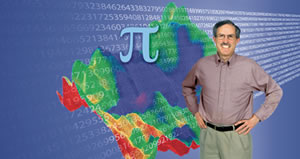 David Bailey, with the digits of pi
David Bailey, with the digits of pi
Even the Berkeley Lab group expected to confirm that expansion was slowing. An article in the Lab’s Research Review in the fall of 1997 noted that “the Supernova Cosmology Project is measuring the universe’s deceleration ... The preliminary results are in and they indicate that the universe appears to be slowing down.”
Whoops.
In January 1998 the SCP, and shortly thereafter the rival High-Z Supernova Search Team, announced a startling discovery: expansion is accelerating. The mutual gravitational attraction of all the matter in the universe, visible and dark, is insufficient to overcome the negative pressure of a mysterious, invisible something that accounts for three-quarters of the density of the universe — something soon to be called dark energy, “the most fundamentally mysterious thing in basic science” and “the biggest embarrassment in theoretical physics,” according to leading cosmologists.
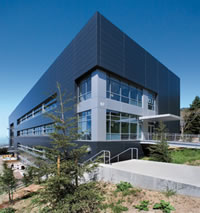 The Molecular Foundry
The Molecular Foundry
In 1999 Perlmutter and his colleagues proposed a SuperNova/ Acceleration Probe, SNAP, to fly a two-meter telescope and a billion-pixel imager using Berkeley Lab’s robust, radiation-resistant, and uniquely red-sensitive astronomical CCD, descended from high-energy particle detectors. The SNAP concept was embraced by DOE (as “nonaccelerator physics”) and soon attracted the attention of NASA. In October 2003 the two agencies joined to mount a competitive Joint Dark Energy Mission, for which SNAP was the inspiration and, while constantly evolving, is still the leading contender.
“The world that we look at is a dynamic world, with movement and a lot of changing events,” said Shank in one of his last state-of-the-lab messages. “Change is true not only of science but of how we view the history of science as time passes.”
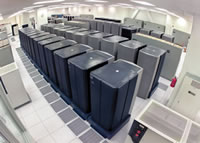 The IBM Seaborg Cluster at NERSC OSF
The IBM Seaborg Cluster at NERSC OSF
Of the many discoveries made at the Lab during Shank’s long tenure, it is impossible to know which of those listed in this near contemporaneous summary — and a great many more that couldn’t be squeezed into the available space — will still seem significant even a decade from now, and which of those not mentioned will emerge as more important. Judgment will have to wait until Berkeley Lab celebrates its 100th anniversary.
Even this close to the action, however, it is clear that the unhappy setbacks of the Shank years were few and fleeting — two new elements turned out not to exist; the ALS got a poor report card, which stimulated the hard work and imagination that produced today’s matchless facility — while the scientific successes were many and substantial.
Next: STEVE CHU’S NEW PERSPECTIVE
Berkeley Lab Science Roundup
 Horst Simon, director of NERSC
Horst Simon, director of NERSC
Cray Wins NERSC Supercomputer Contract
DOE’s Office of Science has announced that Cray Inc. has won the contract to install a next-generation supercomputer at NERSC (National Energy Research Scientific Computing Center). The systems and multi-year services contract, valued at over $52 million, includes delivery of a Cray massively parallel processor supercomputer, code-named “Hood.” It also provides options for future upgrades that would quadruple the size of the system and eventually boost performance to one petaflop and beyond. Cray will begin shipping the new supercomputer to NERSC later this year, with completion of the installation anticipated in the first half of 2007 and acceptance in mid-2007. NERSC director Horst Simon said that based on NERSC’s Sustained System Performance metric, the Hood system will deliver sustained performance of at least 16 trillion calculations per second, with a theoretical peak speed of 100 trillion calculations per second—when running a suite of diverse scientific applications at scale, making it one of the world’s faster general-purpose system. In keeping with NERSC’s tradition of naming supercomputers after world-class scientists, the new system will be called “Franklin” in honor of Benjamin Franklin, America’s first scientist. This year is the 300th anniversary of Franklin’s birth.
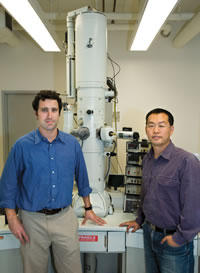 Andrew Minor and Zhiwei Shan are using the JEOL 3010 In Situ Transmission Electron Microscope at NCEM with a sample holder that integrates a capacitive force sensor to correlate load-displacement measurements with individual video frames.
Andrew Minor and Zhiwei Shan are using the JEOL 3010 In Situ Transmission Electron Microscope at NCEM with a sample holder that integrates a capacitive force sensor to correlate load-displacement measurements with individual video frames.
Surprise Finding for Crumpled Nanocrystals
Scientists have long assumed that a nanoscale crystal needs to be perfect to sustain stress at its theoretical limit. Beyond this point dislocations in the crystal lattice occur, and the crystal undergoes a nonreversible change of shape, or plastic deformation. However, things don’t necessarily happen this way, according to the results of a study lead by Andrew Minor and Zhiwei Shan, with Berkeley Lab’s Materials Sciences Division. In a collaboration with scientists from Purdue University and Hysitron Incorporated in Minneapolis, the researchers used special instrumentation with the JEOL 3010 In Situ Transmission Electron Microscope at the National Center for Electron Microscopy (NCEM) to correlate high-resolution load-displacement measurements with individual video frames. The results showed how nanoscale volumes of aluminum deform under stress from a diamond nanoindenter. To the surprise of Minor, Shan and their collaborators, they found that plenty of defects accumulate before the point that would usually be interpreted as the material’s initial yield point. Even when the material had a high defect density it could withstand near-theoretical shear stresses. Minor and Shan said their results challenge the traditional concept of the initial deformation of crystalline materials and raise many new questions about other kinds of nanoscale materials, including thin films, nanowires, and individual nanoparticles.
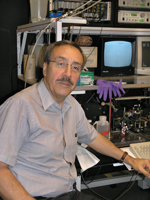 Carlos Bustamante is a leading authority on the use of single-molecule visualization and manipulation techniques. He holds joint appointments with Berkeley Lab, UC Berkeley and the Howard Hughes Medical Institute.
Carlos Bustamante is a leading authority on the use of single-molecule visualization and manipulation techniques. He holds joint appointments with Berkeley Lab, UC Berkeley and the Howard Hughes Medical Institute.
Unexpected Results for Stretched DNA
Stretched to its full length, a single molecule of human DNA extends more than three feet, but, when wound up inside the nucleus of a cell, that same molecule measures about one millionth of an inch across. Biologists have long believed that as a molecule of DNA is stretched, its double helix starts to unwind. As much sense as this makes from an intuitive standpoint, a recent experiment proved it not to be the case. A research team led by Carlos Bustamante, a biophysicist with Berkeley Lab’s Physical Biosciences Division, used a combination of microscopic beads and magnetic tweezers to observe that when a DNA molecule is stretched, it actually begins to overwind. This overwinding continues until the force being applied to stretch the DNA exceeds about 30 picoNewtons. (One picoNewton is about a trillionth the force required to hold an apple against Earth’s gravity.) Beyond the 30 picoNewton threshold, the DNA double helix did begin to unwind in accordance with predictions. These results hold important implications for how DNA-binding proteins are able to recognize their target sites along the helix. Proteins are known to bend, wrap, loop and twist DNA. Now it has been shown that they can achieve their goals by simultaneously stretching and overwinding a DNA molecule, or by compressing and underwinding it.
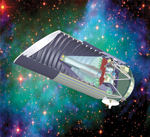 The SuperNova/Acceleration Probe (SNAP)
The SuperNova/Acceleration Probe (SNAP)
SNAP Wins NASA Support for Dark Energy Mission
NASA has announced that it will support an advanced mission concept study for the SNAP experiment, proposed by Berkeley Lab and UC Berkeley’s Space Sciences Laboratory for NASA and DOE’s Joint Dark Energy Mission (JDEM). In addition to SNAP, NASA also selected the ADEPT and DESTINY proposals to perform mission concept studies for JDEM. SNAP, the SuperNova/ Acceleration Probe, is an experiment designed to learn the nature of dark energy by precisely measuring the expansion history of the universe. At present scientists cannot say whether dark energy has a constant value or has changed over time — or even whether dark energy is an illusion, with accelerating expansion being due to a gravitational anomaly instead. Led by Saul Perlmuter, an astrophysicist with Berkeley Lab’s Physics Division, SNAP would measure changes in the expansion rate by comparing the redshift and distance of Type Ia supernovae. SNAP is expected to find thousands of very far-off Type Ia supernovae, measure their magnitude and determine their spectra with unprecedented accuracy, detail, and control.
SNAP will also measure weak gravitational lensing, the bending of light rays by the gravity of background galaxies.
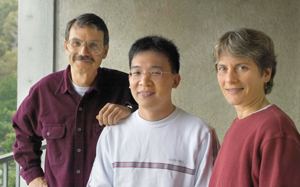 Alex Zettl (left), Xing Chen, and Carolyn Bertozzi have developed a technique for safely interfacing carbon nanotubes with biological cells.
Alex Zettl (left), Xing Chen, and Carolyn Bertozzi have developed a technique for safely interfacing carbon nanotubes with biological cells.
Living with Carbon Nanotubes
Berkeley Lab scientists Carolyn Bertozzi and Alex Zettl, working with graduate student Xing Chen and others, have developed a means of making carbon nanotubes (CNTs) biocompatible. By coating the CNTs with a synthetic polymer that mimics mucin, the substance on cell surfaces that serves as a lubricant, Bertozzi, Zettl, Chen and their collaborators have been able to safely attach them to biological cells. This polymer coating can also be customized to bind to a specific type of cell. CNTs are hollow wires of pure carbon about 50,000 times narrower than the finest human hair but stronger than steel. They have enormous potential in a variety of biological applications, including medical diagnostics and treatments. There’s a problem, however, and until now it has been what technologists call a “stopper.” For reasons not entirely known, CNTs are cytotoxic — contact with them kills biological cells. With this new mucin mimicing polymer technology, it becomes possible to essentially program CNTs to selectively interact with a target cell through the introduction of a variety of alternative ligands and sugars to the polymer coating. The researchers believe their technology will open the door for the application of CNTs to biological systems.
Cosmic Background Explorer (COBE) Team Wins Gruber Prize
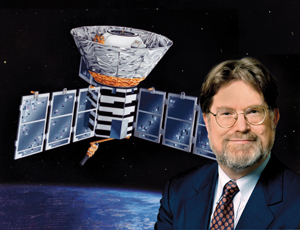
![]() George Smoot shown with an illustration of COBE. The Gruber Prize is shown at left.
George Smoot shown with an illustration of COBE. The Gruber Prize is shown at left.
John Mather, Project Scientist of NASA’s Cosmic Background Explorer satellite mission, and eighteen members of COBE’s Science Working Group, including Lab physicist and UC Berkeley Physics professor George Smoot, have jointly received the 2006 Gruber Cosmology Prize for their groundbreaking studies of the cosmic microwave background (CMB). The COBE experiments not only confirmed that the universe was born in a big bang but shed light on its subsequent structure.
The Gruber Prize was awarded at the opening ceremony of the International Astronomical Union’s General Assembly in Prague on Tuesday, August 15. In response to news of the prize, Smoot said, “We are pleased that the work and results of the COBE scientists, engineers, and staff are being honored by the Gruber Foundation. It was such a pleasure first to participate in COBE’s discoveries, and then again to have them recognized.”
Of the three experiments aboard the COBE satellite, George Smoot was principal investigator of the differential microwave radiometer (DMR) experiment, which used three DMRs to measure minute temperature differences in the cosmic microwave background.
Among the CMB’s most interesting features are minute variations in its temperature in different parts of the sky. Smoot proposed that differential microwave radiometers (DMRs) be carried aboard a satellite to map these differences. His proposal and those of other investigators were combined in the COBE experiment, NASA’s first dedicated cosmology mission, which after many setbacks was finally launched late in 1989. The experiments aboard COBE included three DMRs, with Smoot as principal investigator, a far infrared absolute spectrophotometer (FIRAS), with John Mather as PI, and the diffuse infrared background experiment (DIRBE), with Michael Hauser as PI.
After years of data analysis, COBE’s results confirmed that the cosmic microwave background had indeed originated in the big bang and, from the DMR data, revealed tiny but regular temperature fluctuations, or “wrinkles” in its structure. Variations in the CMB are now recognized as the seeds of the intricate large-scale structures that exist everywhere in the cosmos.
The Gruber Cosmology Prize consists of a gold medal and $250,000 in cash, half of which is awarded to Mather, with the rest divided by COBE Science Working Group members. The Peter Gruber Foundation, based in the Virgin Islands, supports five international awards, in cosmology, justice, genetics, neuroscience, and women’s rights.
People, Awards, and Honors


Lab Receives Energy Commission Awards
The California Energy Commission awarded contracts totaling more than $5.9 million to state research facilities, including EETD’s Bernard Lesieutre, who received over $1.1 million for a research project that will investigate the impacts of new residential air conditioning equipment and electronic equipment on stability performance of the Western grid. EETD’s Joe Eto received $455,000 for the Consortium for Electric Reliability Technology Solutions (CERTS) to develop methods to assess strategic transmission benefits and planning tools.

EETD Scientist Among NAE’s ‘Young Engineers’
Melissa Lunden, with Berkeley Lab’s Environmental Energy Technologies Division, is among 81 of the nation’s brightest young researchers selected to take part in the National Academy of Engineering’s annual “Frontiers of Engineering” symposium. The event brings together engineers ages 30 to 45 who are performing cutting-edge engineering research and technical work in a variety of disciplines. The participants — from industry, academia, and government — were nominated by fellow engineers or organizations and chosen from nearly 200 applicants.
Founders Day - Saturday, Aug. 26 - 10 a.m. to 3 p.m.
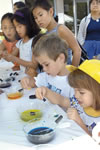
Activities For Kids — Various Locations
Youngsters can bounce to their heart’s content in an inflatable jumper, watch a demonstration of a model cyclotron, and learn about science with hands-on experiments in the Bldg. 50 parking lot.
Additional science activities for kids will be held in Bldg. 7, the Center for Science and Engineering Education.
Those who visit the Lab’s fire station can check out the engines and operate a fire hose.
Pick up a treasure map in the Bldg. 50 parking lot, then find clues to help answer questions about the Lab’s history. Those who complete the challenge win prizes.
Performances — Cafeteria
Stage Area
Fire Spinning: Nuclear sciences graduate student Sarah Nelson will perform fire spinning (weather permitting) at 10:30 and 11:45 a.m. and 1:15 p.m., utilizing various types of equipment, including poi (fire wicks on chains), rope snakes, and staffs, all to upbeat music.
Music: Visitors can listen to Copper Dome Bohdi (11 a.m.), a 1960s psychedelic-inspired group featuring EETD employee Julia Turner as lead singer, R&B classics by the Lab Band (1:30 p.m.), and rock & roll by Lawrence Livermore Lab’s Free Lunch Band (2:15 p.m.).
Dance: Lab nuclear scientist Janis Dairiki will perform along with members of the Berkeley branch of the San Francisco Royal Scottish Country Dance Society, with musical accompaniment provided by Plaid Attitude (12:30 p.m.).
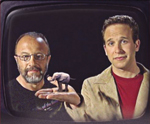
Tours
General Tours: A shuttle bus will take riders on a driving tour of the Lab, highlighting various facilities and landmarks while tour guides impart information on the Lab’s history. Tours will be conducted every hour from 10:30 a.m. to 2:30 p.m. Pick-up and drop-off near the cafeteria parking lot.
Molecular Foundry: Lecture by Mark Alper (11 a.m.), followed by tours.
Advanced Light Source: Every half-hour from 11 a.m. to 2 p.m.
88” Cyclotron: Tours at 11 a.m. and 1:30 p.m.
Noon Ceremony — Cafeteria Stage
Director Steve Chu will welcome those in attendance and dedicate a time capsule, filled with contents suggested by Lab employees.
Congratulatory remarks on the Lab’s 75 years of scientific achievement will be given by representatives from Congress and local government.
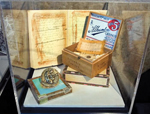
Exhibits
Building 50 Historical Display: View the actual door to Lab founder Ernest Lawrence’s original Lab on campus, some of his early cyclotrons, a time projection chamber prototype, the cardboard cigar box in which Glenn Seaborg carried his plutonium samples, a spark chamber, and various original documents and letters that trace the founding of the Lab.
Arts & Crafts Fair: Handmade jewelry, books, artwork, and photography are among the items that will be displayed in the cafeteria’s dining hall. Some work will be available for purchase.
Car Show: Classic cars and motorcycles will be on display in the cafeteria parking lot, including a 1932 Dodge coupe, a 1950 Studebaker, and a 1959 Austin Healey.
Historical Photo Montages: Mounted in the lobby of the cafeteria, eight panels feature photographs that depict the highlights of each decade of the Lab’s existence.
Environmental Energy Technologies Division: Visit the cafeteria dining hall to learn about the latest research EETD scientists are conducting to develop better energy technologies.
Building 50 Auditorium Cinema
Watch vintage films from the 1930s era, including a Flash Gordon short (10 a.m.) King Kong (10:30 a.m.), and Frankenstein (12:20 p.m.). Also included is a special presentation of When Things Get Small, a film about nanoscience with a live opening presentation by Ivan Schuller, noted nanoscientist and the film’s co-producer (1:30 p.m.). More Flash Gordon at 2:30 p.m.

Activity Booths — Cafeteria Parking Lot
Berkeley Lab Institute: employee development and training
Materials Sciences Division: posters, information on research
EX-Ls: Berkeley Lab retirees organization
UC Berkeley Retirement Center:
Services for UC retirees
Friends of Science: Berkeley Lab public outreach organization
Health Services: blood pressure and body mass index measurements
Body Techniques: free five-minute chair massages
Berkeley Lab Cafeteria: mug and
t-shirt sales, free Coke samples
Joint Genome Institute: hands-on fruit fly DNA experiments
Life Sciences Division: posters, information on research
Information Tent — Cafeteria Parking Lot
Stop by to pick up the day’s program schedule and map, and to get details on tours, food, bathrooms, and first-aid.
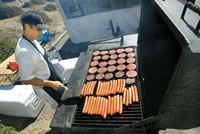
Food
Visitors can purchase $6 tickets, which include choice of hamburger, veggie burger, BBQ chicken sandwich or pizza slice, and cole slaw or potato salad, and soda or bottled water, and dessert. A $3 Kids’ Meal includes pizza slice, drink and dessert.
Tickets will be sold prior to the event at the cafeteria coffee bar and on Founders Day in the cafeteria lobby and the cafeteria’s activity booth. Seating will be available in the dining hall, Perseverance Hall, in the outdoor patio adjacent to the cafeteria, and the lawn area next to Bldg. 70. The coffee bar will also be open.
Access, Parking and Transportation
Cars with a Berkeley Lab parking permit or an occupant with employee ID card can enter through Blackberry or Strawberry Gates. Visit the Founders Day website to print out a pass for guests arriving separately (requires LDAP username and pass-word). Visitors can park in all lots except H1, H2, cafeteria, and Bldg. 50 lots. A limited amount of handicap parking will be available in the cafeteria lot. Shuttle buses will bring guests (with special pass or employee ID) to and from the Lab from downtown Berkeley. See website for schedule and stops. Onsite buses will circulate the Lab during the event.